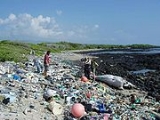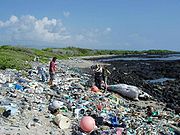
Kamilo Beach
Encyclopedia

Hawaii (island)
The Island of Hawaii, also called the Big Island or Hawaii Island , is a volcanic island in the North Pacific Ocean...
. It is known for its accumulation of plastic marine debris
Marine debris
Marine debris, also known as marine litter, is human created waste that has deliberately or accidentally become afloat in a lake, sea, ocean or waterway. Oceanic debris tends to accumulate at the centre of gyres and on coastlines, frequently washing aground, when it is known as beach litter or...
from the Great Pacific Garbage Patch
Great Pacific Garbage Patch
The Great Pacific Garbage Patch, also described as the Pacific Trash Vortex, is a gyre of marine litter in the central North Pacific Ocean located roughly between 135°W to 155°W and 35°N to 42°N...
.
History
In ancient times, Kamilo Beach was a location where Native HawaiiansNative Hawaiians
Native Hawaiians refers to the indigenous Polynesian people of the Hawaiian Islands or their descendants. Native Hawaiians trace their ancestry back to the original Polynesian settlers of Hawaii.According to the U.S...
would go to find large evergreen
Pinales
The Order Pinales in the Division Pinophyta, Class Pinopsida comprises all the extant conifers. This order was formerly known as the Coniferales....
logs, drifted ashore from the Pacific Northwest
Pacific Northwest
The Pacific Northwest is a region in northwestern North America, bounded by the Pacific Ocean to the west and, loosely, by the Rocky Mountains on the east. Definitions of the region vary and there is no commonly agreed upon boundary, even among Pacific Northwesterners. A common concept of the...
, for building dugout canoes. It was also a location where those who were lost at sea might eventually wash ashore.
Description
Kamilo Beach is approximately 1500 feet (457.2 m) long, and is located on the remote southeast coast of the Kaū DistrictKau, Hawaii
thumb|right|300px|The districts of the [[Hawaii |Big Island]]. From Northernmost, clockwise; [[Kohala, Hawaii|Kohala]], [[Hamakua]], [[Hilo, Hawaii|Hilo]], [[Puna, Hawaii|Puna]], Kau , [[Kona District, Hawaii|Kona]]...
on the island of Hawaii, at coordinates 18°58′13"N 155°35′59"W. There are no paved roads to the beach.
This beach, situated on a lower lava terrace, is a storm beach. It was formed by the deposit of large amounts of sand blown by prevailing winds.
At the point of Kamilo, waves have cut a large indentation, creating a variety of rocky points, ponds, and channels. Most of these are exposed during low tides, and are awash during high tides.
The debris is situated on the narrow, crescent-shaped strip of white sand, formed along the inland border of this area.
The beach is an accumulation zone for plastic
Plastic
A plastic material is any of a wide range of synthetic or semi-synthetic organic solids used in the manufacture of industrial products. Plastics are typically polymers of high molecular mass, and may contain other substances to improve performance and/or reduce production costs...
trash. The debris is forced onto the beach by constant trade winds
Trade wind
The trade winds are the prevailing pattern of easterly surface winds found in the tropics, within the lower portion of the Earth's atmosphere, in the lower section of the troposphere near the Earth's equator...
and converging ocean currents
Ocean current
An ocean current is a continuous, directed movement of ocean water generated by the forces acting upon this mean flow, such as breaking waves, wind, Coriolis effect, cabbeling, temperature and salinity differences and tides caused by the gravitational pull of the Moon and the Sun...
.
The backshore at Kamilo contains such vegetation as naupaka, milo, and ironweed.
Debris
The accumulated garbage that covers Kamilo Beach and an adjacent 2.8 miles (4.5 km) of shoreline consists of 90% plastic. Although some of the items comprising the trash are household products, the vast majority are fishingFishing
Fishing is the activity of trying to catch wild fish. Fish are normally caught in the wild. Techniques for catching fish include hand gathering, spearing, netting, angling and trapping....
related such as nets, rope, cones used to trap hagfish
Hagfish
Hagfish, the clade Myxini , are eel-shaped slime-producing marine animals . They are the only living animals that have a skull but not a vertebral column. Along with lampreys, hagfish are jawless and are living fossils whose next nearest relatives include all vertebrates...
, spacers used in oyster farming
Oyster farming
Oyster farming is an aquaculture practice in which oysters are raised for human consumption. Oyster farming most likely developed in tandem with pearl farming, a similar practice in which oysters are farmed for the purpose of developing pearls...
, buoy
Buoy
A buoy is a floating device that can have many different purposes. It can be anchored or allowed to drift. The word, of Old French or Middle Dutch origin, is now most commonly in UK English, although some orthoepists have traditionally prescribed the pronunciation...
s, crates, and baskets.
Part of the debris is made from plastic pellets, either pre-production nurdle
Nurdle
Plastic particles are an increasing cause of water pollution. The particles include nurdles, microbeads from cosmetics products and the breakdown products of plastic litter. Nurdles are pre-production plastic resin pellet typically under in diameter found outside of the typical plastics...
s or pellets created from larger plastic items breaking down into smaller pieces. These smaller pieces are referred to as "plastic sand", and now exceed the volume of the beach's natural sand.
Environmental impact
WildlifeWildlife
Wildlife includes all non-domesticated plants, animals and other organisms. Domesticating wild plant and animal species for human benefit has occurred many times all over the planet, and has a major impact on the environment, both positive and negative....
in the area has suffered significant damage due to the on- and off-shore garbage. Fishing debris, such as discarded fishing net
Fishing net
A fishing net or fishnet is a net that is used for fishing. Fishing nets are meshes usually formed by knotting a relatively thin thread. Modern nets are usually made of artificial polyamides like nylon, although nets of organic polyamides such as wool or silk thread were common until recently and...
s and lines
Fishing line
A fishing line is a cord used or made for angling. Important parameters of a fishing line are its length, material, and weight...
, drowns
Drowning
Drowning is death from asphyxia due to suffocation caused by water entering the lungs and preventing the absorption of oxygen leading to cerebral hypoxia....
, strangles
Strangling
Strangling is compression of the neck that may lead to unconsciousness or death by causing an increasingly hypoxic state in the brain. Fatal strangling typically occurs in cases of violence, accidents, and as the auxiliary lethal mechanism in hangings in the event the neck does not break...
, and traps birds and marine mammal
Marine mammal
Marine mammals, which include seals, whales, dolphins, and walruses, form a diverse group of 128 species that rely on the ocean for their existence. They do not represent a distinct biological grouping, but rather are unified by their reliance on the marine environment for feeding. The level of...
s.
Some types of plastic and their constituents, such as bisphenol A
Bisphenol A
Bisphenol A is an organic compound with two phenol functional groups. It is used to make polycarbonate plastic and epoxy resins, along with other applications....
, bis(2-ethylhexyl) phthalate
Bis(2-ethylhexyl) phthalate
Bisphthalate, commonly abbreviated DEHP, is an organic compound with the formula C6H42. It is sometimes called dioctyl phthalate and abbreviated DOP. It is the most important "phthalate," being the diester of phthalic acid and the branched-chain 2-ethylhexanol. This colourless viscous liquid is...
, and polystyrene
Polystyrene
Polystyrene ) also known as Thermocole, abbreviated following ISO Standard PS, is an aromatic polymer made from the monomer styrene, a liquid hydrocarbon that is manufactured from petroleum by the chemical industry...
, leach carcinogen
Carcinogen
A carcinogen is any substance, radionuclide, or radiation that is an agent directly involved in causing cancer. This may be due to the ability to damage the genome or to the disruption of cellular metabolic processes...
ic or poisonous chemicals when they break down
Biodegradation
Biodegradation or biotic degradation or biotic decomposition is the chemical dissolution of materials by bacteria or other biological means...
. Others absorb toxin
Toxin
A toxin is a poisonous substance produced within living cells or organisms; man-made substances created by artificial processes are thus excluded...
s such as DDT
DDT
DDT is one of the most well-known synthetic insecticides. It is a chemical with a long, unique, and controversial history....
and polychlorinated biphenyl
Polychlorinated biphenyl
Polychlorinated biphenyls are a class of organic compounds with 2 to 10 chlorine atoms attached to biphenyl, which is a molecule composed of two benzene rings. The chemical formula for PCBs is C12H10-xClx...
s from their surroundings. These toxins are absorbed by animals when consumed.
Cleanup efforts
At least three major cleanup efforts have taken place on Kamilo Beach in recent years. Prior to the efforts, the debris was 8 to 10 ft (2.4 to 3 m) high in some places. Efforts to clean up marine debris from Kamilo Beach have included those by the Hawaii Wildlife Fund and Beach Environmental Awareness Campaign Hawaii. In February 2006, the Hawaii Wildlife Fund organized 120 volunteers and removed 400 garbage bags of debris and up to 10 tons (9 tonnes) of fishing nets from the beach.In November 2007, Beach Environmental Awareness Campaign Hawaii volunteers removed more than 4 million pieces of plastic from Kamilo Beach.

